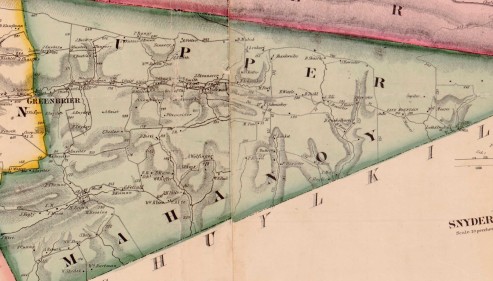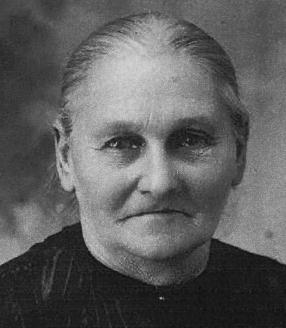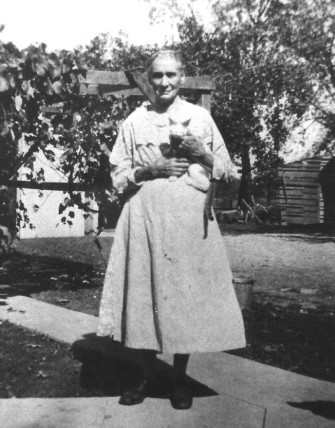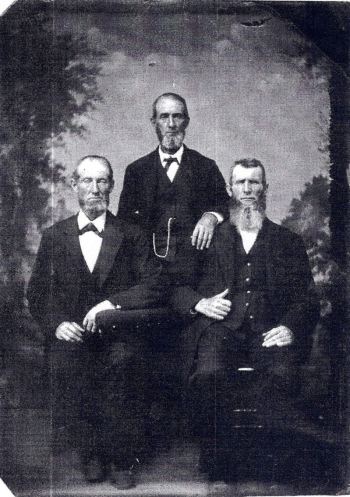Week 11: #52 Ancestors – Large Family
By Eilene Lyon
Large families used to be the norm, particularly in our country’s agrarian years. Studies on U. S. fertility rates show that the average births per woman in 1800 was over 7.0.1 Given that some women had no children and others had a low number due to death during childbirth, widowhood, or other factors, it’s clear that some women had way more than seven children. As of 2016, fertility in the U. S. dipped to 1.8 and shows no sign of reversal.2
And given that men are capable of having children essentially for their entire post-puberty lives, it’s not unusual for one man to have an enormous number of kids. In my family, the all-time fecundity champion is my 3rd great-grandfather, Samuel Paul, who had 18 known children by two wives, with only two not surviving to adulthood.
One descendant has asserted that the second wife, Lydia Hedrick, had an additional three children for which no evidence remains.3 If true, that would put Samuel at 21 children. Certainly not a record, but not the norm, either. Unfortunately, there are no family group photos for this big clan.

Samuel Paul was the grandson of Eva Dockenwadel and Georg Paul, two German immigrants. His parents were Michael Paul and Elizabeth Geissinger, who settled in the “Pennsylvania Dutch” region. He was one of ten children in this German-speaking family. Per census records, Samuel was not taught to read or write and spent his life farming.
Samuel was born in 1804 in Upper Mahanoy Township, Northumberland County, Pennsylvania.4 About 1828, he married Catharina Hepler, the 18-year-old daughter of Peter Hepler and Anna Maria Wagner.5 They had five children together: Peter, Elizabeth, Catherine, Mary (my ancestor), and Salome. It appears that Catharina died in June 1838, a few months after the birth of her fifth child.6

It’s probable that Samuel and Lydia married sometime in 1839 or early 1840. Their first child, Abigail Evaline Paul, was born in November 1840.7 Lydia continued to have children at a normal pace until her last child, William, was born in 1867, when Lydia was 46 years old.8 All the family spoke German at home.9

Sometime between the birth of daughters Harriet and Sarah, in 1846 and 1847, the Pauls moved to Tipton County, Indiana. According to family lore, game was abundant there and Lydia could hunt and dress a deer as well as anyone.10 Samuel’s brother, Isaac, also made the move to Indiana. Samuel’s oldest brother, Johann Paul, moved to Ohio and became known as John Powell, complicating family research a bit.

Having a lot of children didn’t seem to be very good for Samuel’s financial state, and being illiterate and German-speaking probably weren’t helping, either. In 1850, with ten children at home, his farm was worth $2,000.11 By 1860, with eleven children in the home, his real estate was valued at $500.12 By 1870, it dropped to $300.13
Lydia Hedrick Paul was reputed to be a volatile, jealous woman who burned the family house to the ground during one of her rages. Whether this is true or not – who can say? This is supposedly the reason that many family history documents no longer exist. At any rate, Samuel and Lydia parted ways about 1878, possibly getting divorced.14
Samuel went to live with his daughter, Mary, who by then was living in Columbus, Johnson County, Missouri.15 According to family history, he died there on April 8, 1884, but no one has ever found a record for his death or burial.
Samuel Paul on Ancestry
Feature image: Samuel Paul in later life (unknown source)
Many records for the Paul, Hepler, and Hedrick families are found in the archives of Howerter’s Church in Northumberland County at http://files.usgwarchives.net/pa/northumberland/church/howert2.txt
- https://eh.net/encyclopedia/fertility-and-mortality-in-the-united-states/ ↩
- https://data.worldbank.org/indicator/SP.DYN.TFRT.IN?locations=US ↩
- Extract from notes of June (Paul) Meacham, “History of my father and Grandfather Paul’s side of the family” p. 1. ↩
- Michael Paul. Year: 1810; Census Place: Upper Mahanoy, Northumberland, Pennsylvania; Roll: 53; Page: 260; Image: 00097; Family History Library Film: 0193679 – via Ancestry.com. ↩
- This is according to some research done by a cousin who translated some family records from German. I have not seen the documentation. ↩
- https://www.findagrave.com/memorial/165866037 Death date is not documented. ↩
- Abbie Redmon. Year: 1900; Census Place: Peru, Miami, Indiana; Page: 15; Enumeration District: 0103; FHL microfilm: 1240393 – via Ancestry.com. ↩
- William Paul. Year: 1870; Census Place: Liberty, Tipton, Indiana; Roll: M593_363; Page: 508A; Family History Library Film: 545862 – via Ancestry.com. ↩
- Meacham, p. 1. ↩
- Ibid. ↩
- Samuel Paul. Year: 1850; Census Place: Cicero, Tipton, Indiana; Roll: M432_176; Page: 239B; Image: 11 – via Ancestry.com. ↩
- Samuel Paul. Year: 1860; Census Place: Cicero, Tipton, Indiana; Roll: M653_301; Page: 15; Family History Library Film: 803301 – via Ancestry.com. ↩
- Samuel Paul. Year: 1870; Census Place: Liberty, Tipton, Indiana; Roll: M593_363; Page: 508A; Family History Library Film: 545862 – via Ancestry.com. ↩
- “Samuel Paul Family.” Compiled by Marietta F. Henry, p. 1. ↩
- Samuel Paul. Year: 1880; Census Place: Columbus, Johnson, Missouri; Roll: 696; Page: 261A; Enumeration District: 097 – via Ancestry.com. ↩

I just love that last pic. You’ve been busy at it still I see. How’s the book coming along?
LikeLiked by 1 person
Thanks! I have the first draft done. I’m taking a research trip to CA in a couple weeks, then I’ll get started on the re-write. Did you finish yours? Sorry I didn’t get around to reading more of it.
LikeLiked by 1 person
Oh that’s fine. I’m letting it stew and then I’m going through it one more time. I get a better perspective and can see the problems after shelving it. I’m shooting for Christmas time.
LikeLiked by 1 person
Yes, I’m doing the same! Fermenting more than stewing😉
LikeLike
Ah, that sounds even better. My book is a stew though. With no recipe.. hah!
LikeLike
Eilene,
First of all, the title. Fecundity is a great word, just saying.
And then I read this story and I keep coming back to the same thing over and over again. Seven? In 218 years, it has decreased by more than five children? I can’t get past that one.
LikeLiked by 1 person
Lots of reasons for that, of course. Reliable birth control, education, movement from farms to cities, etc.
LikeLiked by 1 person
Indeed. But still, the idea that seven was the average number is quite something.
LikeLiked by 1 person
I can hardly imagine! (But then, I’m in the zero category.)
LikeLiked by 1 person
Even the Amish, whose culture is still so firmly rooted to the past, have adopted a lot of today’s methods as per birth control.
Every now and again, you see a family of seven or eight children, but it’s not nearly as prevalent.
LikeLiked by 1 person
My mother was the 13th and last child of her family born in 1920 and lots of my family research shows family sizes of 10+ children across the 1800s. I wonder why this was? In today’s values it’s about economics, careers and available reliable birth control, but surely back in Victorian England poverty would have been a strong driver to keep family size DOWN? Unless it’s Darwinian, with a mortality rate much higher than today larger families had a greater chance of continuity?
LikeLiked by 1 person
Childhood mortality was certainly high. No antibiotics or really any effective medicines. My great-grandmother was also the youngest of 13 and only 6 survived to adulthood.
LikeLiked by 1 person
As I go back in time I’m finding wives who died quite young, 35 yr old for example, around the time of the birth of the final child. I can’t be certain of childbirth as the cause as I can’t tie dates together but often occurring in the same year.
LikeLiked by 1 person
I find it difficult to tie the two events together as well. Sometimes the dates are available, but many times just the year.
LikeLiked by 1 person
Infuriating!
LikeLiked by 1 person
I grew up in a family of thirteen. We had one bathroom – and my father was a plumber. Figure that one out. What I learned about large families, is that whenever you go to use the bathroom, there is a sister in it.
When I left home and bought my first house, I made sure it had two bathrooms, just in case. The first time I went to use the master bath – one of my sisters was camping in there.
LikeLiked by 1 person
LOL. Really? That seems quite unusually large a family in these times. One bathroom had to be a nightmare!
LikeLiked by 1 person
In our neighborhood, a family of thirteen was considered slackers. There were 56 kids in my class and when I say class, I mean classroom. It was a 1950’s thing.
LikeLiked by 1 person
I know some families were the model of fecundity, but I’m always a bit skeptical when I see over 20 or so children in one family – because it’s often easy to mistakenly attach uncles/cousins etc. to the wrong parents. It happens, but yes, so does fecundity (what a fun word! :o)
LikeLiked by 1 person
I think the family did document these children. I found baptismal records for all the ones born in Pennsylvania (to both mothers).
LikeLike
Interesting to me that when Johann Paul moved to Ohio he became John Powell. Powell is a popular name in this state, but I never knew it could be a revision of a German immigrant name. Considering how many German immigrants came to Ohio, it all makes sense to me now.
LikeLiked by 1 person
It makes you realize that the last name Paul probably wasn’t pronounced the way we would assume.
LikeLiked by 1 person
Love this article about large families. We need them to come back to America!!! My wife and I currently have 7 with our 8th child coming in 7 weeks from now. God said be fruitful and multiply and we trust in Him to continue to bless us.
LikeLike